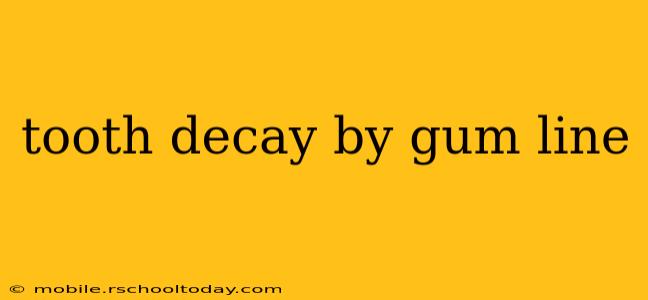Tooth decay, also known as dental caries, is a common problem that can occur anywhere on the tooth. However, decay at the gum line presents unique challenges because it's often harder to detect and can progress more rapidly. This comprehensive guide explores the causes, symptoms, and treatment options for tooth decay near the gum line.
What Causes Tooth Decay at the Gum Line?
Several factors contribute to tooth decay developing at the gum line:
-
Poor Oral Hygiene: Insufficient brushing and flossing allow plaque, a sticky film of bacteria, to accumulate along the gum line. This plaque produces acids that erode tooth enamel, leading to cavities. Failing to remove food particles trapped near the gums creates a breeding ground for bacteria.
-
Receding Gums: As gums recede, more of the tooth root becomes exposed. Root surfaces are less protected by enamel, making them more susceptible to decay. This is particularly prevalent in individuals with gum disease (gingivitis or periodontitis).
-
Diet: A diet high in sugary and acidic foods and drinks weakens tooth enamel, increasing vulnerability to decay. The constant exposure to these substances, especially if not immediately followed by brushing, accelerates the decay process, particularly near the gum line where food particles tend to linger.
-
Dry Mouth: Saliva plays a crucial role in neutralizing acids and washing away food particles. Reduced saliva production (xerostomia), often due to medication or medical conditions, increases the risk of gum line decay.
-
Underlying Medical Conditions: Certain medical conditions and medications can compromise oral health, making individuals more prone to tooth decay, including at the gum line.
What Are the Symptoms of Gum Line Decay?
Detecting decay at the gum line can be tricky as it often doesn't present obvious symptoms in the early stages. However, watch out for these warning signs:
-
Discoloration: The affected area may appear darker than the surrounding tooth enamel, possibly brown or black.
-
Sensitivity: Increased sensitivity to hot, cold, sweet, or sour foods and drinks is a common symptom.
-
Pain: As the decay progresses, you may experience pain, especially when chewing or biting.
-
Bad Breath: Persistent bad breath (halitosis) can indicate underlying oral health issues, including gum line decay.
-
Visible Cavities: In advanced stages, a visible cavity or hole may develop near the gum line.
How is Tooth Decay at the Gum Line Treated?
Treatment options depend on the severity of the decay:
-
Fluoride Treatments: For early-stage decay, fluoride treatments can help strengthen the enamel and prevent further progression.
-
Fillings: If the decay has penetrated the enamel, your dentist will likely remove the affected tooth structure and fill the cavity with a composite resin, amalgam, or other filling material.
-
Crowns: For more extensive decay, a crown may be necessary to protect and restore the damaged tooth.
-
Root Canal: If the decay reaches the pulp (the inner part of the tooth containing nerves and blood vessels), a root canal might be required to remove the infected tissue and save the tooth.
-
Extraction: In severe cases where the tooth is beyond repair, extraction may be the only option.
Can Gum Line Decay Be Prevented?
Preventing tooth decay at the gum line is crucial. Here are some preventative measures:
-
Maintain Excellent Oral Hygiene: Brush your teeth twice daily with fluoride toothpaste and floss daily to remove plaque and food particles from the gum line.
-
Regular Dental Checkups: Schedule regular visits to your dentist for professional cleanings and examinations. Early detection is key to effective treatment.
-
Healthy Diet: Limit sugary and acidic foods and drinks. Rinse your mouth with water after consuming acidic beverages.
-
Manage Dry Mouth: If you experience dry mouth, talk to your doctor or dentist about ways to increase saliva production or manage its effects.
What if I have receding gums? How does this impact decay risk?
Receding gums expose the root surfaces of your teeth, which are less resistant to decay than enamel. This increased vulnerability makes maintaining impeccable oral hygiene even more critical. Regular dental checkups are essential for early detection and treatment of any developing decay. Your dentist may also recommend therapeutic interventions to address gum recession and reduce further risk.
How is tooth decay near the gum line diagnosed?
Diagnosis typically involves a visual examination by your dentist, along with X-rays to assess the extent of the decay. Your dentist may also use specialized tools to check for sensitivity and the presence of cavities. Early diagnosis is vital for effective and less invasive treatment options.
Does gum disease increase the risk of tooth decay?
Yes, absolutely. Gum disease weakens the gum tissues, leading to gum recession. This exposes the root surfaces of your teeth, increasing susceptibility to decay. Proper gum disease management is vital to protecting your teeth from decay.
By diligently following these prevention and treatment strategies, you can significantly reduce your risk of tooth decay at the gum line and maintain a healthy smile for years to come. Remember, early detection and intervention are key to preventing serious complications. Consult your dentist if you have any concerns about your oral health.
